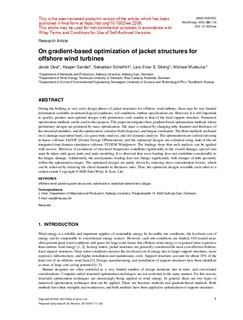On gradient-based optimization of jacket structures for offshore wind turbines
Journal article, Peer reviewed
Accepted version

Åpne
Permanent lenke
http://hdl.handle.net/11250/2609788Utgivelsesdato
2018Metadata
Vis full innførselSamlinger
Sammendrag
During the bidding or very early design phases of jacket structures for offshore wind turbines, there may be very limited information available on meteorological conditions, soil conditions, turbine specifications, etc. However, it is still important to quickly produce near‐optimal designs with production costs similar to that of the final support structure. Numerical optimization methods can be used to this purpose. This paper investigates three gradient‐based optimization methods, where preliminary designs are produced by mass optimization. The mass is reduced by changing tube diameter and thickness of the structural members, and the optimization considers both frequency and fatigue constraints. The three methods are based on (1) damage equivalent loads, (2) quasi‐static analysis, and (3) dynamic analysis. The optimizations are conducted using in‐house software JADOP (jacket design optimization), and the optimized designs are evaluated using state‐of‐the‐art integrated time‐domain simulation software FEDEM Windpower. The findings show that each analysis can be applied with success. However, if excitations of structural frequencies contribute significantly to the overall damage, special care must be taken with quasi‐static and static modeling. It is observed that wave loading does not contribute considerably to the fatigue damage. Additionally, the aerodynamic loading does not change significantly with changes of tube geometry within the optimization ranges. The optimized designs are partly driven by reducing stress concentration factors, which can be achieved by reducing the chord diameter to thickness ratio. Thus, the optimized designs resemble each other to a certain extent.